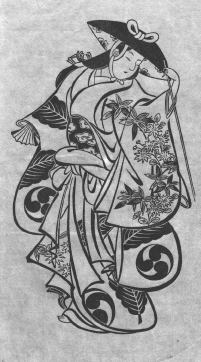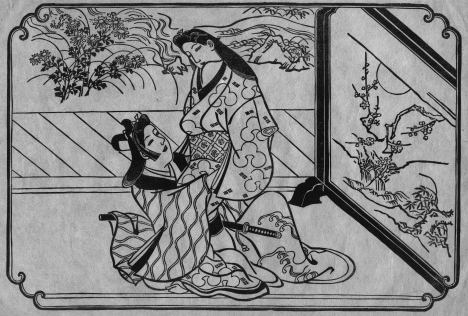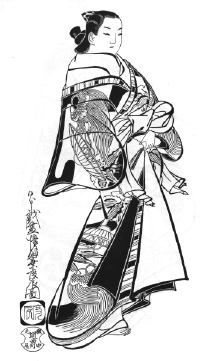Seditious Beauty
In the early 1600's, when Ieyasu, the
founder of the Tokugawa dynasty, finally achieved his dream of
becoming 'shogun', the grand military ruler of all Japan, he
immediately started to set up an intricate and complex arrangement of
rules designed to govern the behaviour of all inhabitants of the
country. His motivation was very clear, the restriction of social
mobility, the preservation of the status quo, and thus the
prolongation of his (and his descendants) position as rulers of the
nation for as long as possible. From quite some time before this,
Japanese society had been stratified into horizontal layers, with
everybody's position on the scale made very clear, from the
figurehead status of the emperor at the top, down through nobility,
warriors, farmers, artisans, merchants, and so on, right down to the
absolute bottom, the outcasts, but this was now codified and set in
concrete. Almost every possible aspect of life was regulated - what
fabrics and patterns of clothing were permitted to each class, what
types of house could be built, to what extent people could travel,
communication with people of other classes, and of course what kind
of daily activities were allowed. Ieyasu's prescription for
maintaining power turned out to be extremely effective. For over two
and a half centuries (1603-1868) his family reigned over the country,
an enormously long time, especially when compared with the wars and
chaos ravaging Europe during the same period.
 But
rules were only rules, and reality was something different entirely.
Although the concept worked very well for the first hundred years or
so (at least from the Tokugawa family's point of view), it was
impossible to 'stop the clock' completely in actual practice, and
strains gradually appeared in the system. One of the biggest problems
concerned money. The warrior class had traditionally been compensated
for their services in rice, rather than with actual negotiable
currency. The allotment of rice they received served to support their
family and retainers, and this was adequate as long as they
maintained an exclusively traditional lifestyle. But gradually
arising in the cities, especially in Edo (old Tokyo), was a new
lifestyle, one being led by a newly enriched merchant class, and in
which money played an ever-increasing role. The men of this
mercantile class were poor in status, standing very low in the social
hierarchy, but were increasingly rich in actual cash, obtained
through their manufacturing or trading activities.
But
rules were only rules, and reality was something different entirely.
Although the concept worked very well for the first hundred years or
so (at least from the Tokugawa family's point of view), it was
impossible to 'stop the clock' completely in actual practice, and
strains gradually appeared in the system. One of the biggest problems
concerned money. The warrior class had traditionally been compensated
for their services in rice, rather than with actual negotiable
currency. The allotment of rice they received served to support their
family and retainers, and this was adequate as long as they
maintained an exclusively traditional lifestyle. But gradually
arising in the cities, especially in Edo (old Tokyo), was a new
lifestyle, one being led by a newly enriched merchant class, and in
which money played an ever-increasing role. The men of this
mercantile class were poor in status, standing very low in the social
hierarchy, but were increasingly rich in actual cash, obtained
through their manufacturing or trading activities.
With increasing amounts of money on hand, and
expanding amounts of leisure time available, it was inevitable that
new forms of social activity would arise, and this period saw the
development of two institutions that would help to transform large
parts of society, and contribute greatly to the eventual breakup of
the feudal class system; the kabuki theater and the 'Yoshiwara', the
red-light district. Not coincidentally, the art that we now know as
Ukiyo-e had a significant role to play in both of these.
Although the origins of the kabuki theater lie
many years before the Tokugawa era, it could not flower until these
necessary circumstances arose. It became hugely popular, attracting
not only townsmen and merchants, but also, much to the displeasure of
the rulers, members of the samurai class. Woodblock prints played an
important part in the life of the theater, not just as
'advertisements' for the actors and productions, but as an integral
part of the experience of visiting the theater. In an era with no
television or newspapers, they performed the essential function of
disseminating the theatrical experience to an audience far wider than
simply those people who attended the productions. The problem, from
the point of view of the authorities, was that the plays invariably
moved into areas where the subject matter was at variance with the
'official' line, and there was constant friction between the theaters
and those wishing to proscribe their activities. The woodblock prints
were not excepted from these battles, and all designs had to obtain
the censor's approval before production. Despite this pressure to
conform, the prints continued to be a contributing factor to social
change, and even such a famous designer as Utamaro spent a term
imprisoned for producing material considered to be critical of the
shogun.
Although on a far more 'private' scale than the
noisy theater, with most of its activities taking place in seclusion,
the Yoshiwara was perhaps a more vital agent of social change.
Sometimes referred to nowadays as the 'green houses', the brothels
there provided far more than simple sexual services. They were places
for townsmen to meet, to spend leisure time, to discuss affairs of
the day, and of course to make romantic assignations. Unlike the
image of similar European institutions of the time, where one can
imagine revolution being plotted under the noses of the king's
agents, the Edo townsmen were not concerned with overthrowing the
government. But their pursuit of basically hedonistic activities,
including poetry readings, discussions of recent novels, showing off
recent acquisitions of new clothing or the like, served to undermine
the stated goal of the regime to keep 'everyone in his place'. And
... they started to attract men from the warrior class.

The major attraction at these places
was obviously the women, and there was fierce competition between
them for customers. No expense was spared when it came to clothing,
hairdos, or other accessories. The fame of the women spread far and
wide, and the status in society of those of the top rank can perhaps
most easily be understood by comparison with someone like Marilyn
Monroe, as a kind of dream figure - unreachable and untouchable by
normal men. Only the most wealthy and favoured could ever hope to
have a woman like this attend their affair in the tea house, and this
was the nub of the problem for the authorities. When status in
society started to be measured by the prestige of the courtesan one
could buy, rather than by one's birthright and place in the
heirarchy, the end of the feudal society was in sight.
Of course, for the masses at large, who could
never hope to even catch a glimpse of these famous courtesans, the
prints would have to suffice. They were run off in the thousands, and
were eagerly snapped up by the Edo populace. The effect on society of
these images was immense, just as that of Monroe has been over the
past few decades in our time. Remember again, there were no
newspapers, magazines, movies, photographs ... All the power of all
of our varied media were concentrated in one single outlet -
woodblock prints.
 These women and
their tea-house environment were thus a
major driving force in the shaping of late Edo-era thinking. The
battle raged back and forth over the years, the government coming out
with a constant stream of regulations to try and maintain the power
of the regime - rules about permitted colours on clothing, what
hairstyles were allowed, what plays could be performed, and what
books could be read ... but always the townsmen found new ways to
express their desire for a different kind of life, and looked to the
Ukiyo-e for guidance. What it was they were looking for they could
perhaps not have even described, but they knew they were not willing
to accept the status quo. When the outside world finally came
knocking on Japan's door in the mid-1800's, the preparatory work had
been done. The feudal society, so outwardly strong and solid, was
hollow at the core. It collapsed in chaos, and a new society arose in
its place.
These women and
their tea-house environment were thus a
major driving force in the shaping of late Edo-era thinking. The
battle raged back and forth over the years, the government coming out
with a constant stream of regulations to try and maintain the power
of the regime - rules about permitted colours on clothing, what
hairstyles were allowed, what plays could be performed, and what
books could be read ... but always the townsmen found new ways to
express their desire for a different kind of life, and looked to the
Ukiyo-e for guidance. What it was they were looking for they could
perhaps not have even described, but they knew they were not willing
to accept the status quo. When the outside world finally came
knocking on Japan's door in the mid-1800's, the preparatory work had
been done. The feudal society, so outwardly strong and solid, was
hollow at the core. It collapsed in chaos, and a new society arose in
its place.
It is impossible to overestimate the role that
Ukiyo-e prints played in this long process of change. The prints were
everywhere in society. Members of a poetry circle meeting at a
tea-house would have their best work engraved and printed for
circulation, perhaps accompanied by a design from Suzuki Harunobu,
who specialized in such work. The townsman's wife would eagerly
peruse the latest prints in a book shop, looking for information on
the latest fashions and hair styles. Sumo wrestlers, historical
heroes, folk tale figures, all figured widely in the prints. It is
hard to find any aspect of the culture of the day that was not
included. The prints were as representative of their society as any
stack of magazines in our local bookstore is of ours now. And just as
we consider 'Focus' magazine to be anything but high art, the people
of that day would never have thought of their prints as anything
special. The men who created them were simple 'shokunin' or workmen,
and even the designers, who we now consider to be among the world's
greatest artists, had a social status ranking far, far below such
people as calligraphers or painters in antique Chinese styles.
Ukiyo-e prints were not 'art', they were 'commerce'. They were not
pretentious works, but simple honest expressions of the culture of
the day, shaped by that culture, and in turn helping to shape it.
They were a vital force for social change, as revolutionary as any
political pamphlets could have been. If they had not existed, the
course of Japanese history would have been vastly different. Any
single print of a beautiful courtesan could not cause the overthrow
of the feudal society, but the Ukiyo-e as a whole certainly played a
major role, and that is perhaps the highest possible accolade that
can be paid to any genre of art. It is certainly fitting that these
prints have finally, in our century, found the respect and
understanding that they did not get in their original society. May
they stand forever as symbols of the power of art to change the
world.
(The three illustrations accompanying this story are of prints
that I made for 'training', back when I lived in Canada ...)